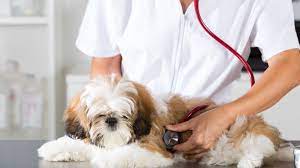Can dogs also get hemorrhoids that bleed? Yes, this gruesome and painful condition can also affect our beloved pets. Hemorrhoids are enlarged blood vessels in the lower anus or rectum of people. They are mainly internal but can protrude externally as well. To put it succinctly, they are a literal and very real pain in the behind. Dogs rarely develop hemorrhoids because their anatomy differs from that of humans. When they do, however, rapid medical attention is required. They can occur when the blood vessels in your dog’s anus get swollen. Because of the increased blood flow, the vessels continue to expand.
What are the Causes of Hemorrhoids in Dogs?
Dog hemorrhoids happen when there is pressure in the rectal area and the blood vessels in that area get bigger. If the blood flow goes up, the swollen blood vessels will stick out even more and form hemorrhoids. Veterinarians believe that a poor diet combined with low muscle tone may also contribute to the development of hemorrhoids.
A hereditary component of hemorrhoids is also possible. Let’s look at the most common causes of hemorrhoids in dogs.
- Age: Dogs’ bodies naturally become less flexible and more prone to injury as they age. A similar thing happens in their digestive system, putting strain on the muscles and ligaments that support the blood vessels in the anus area. Hemorrhoids may develop as a result of this.
- Genetics: Just as in humans, if your dog’s parents or siblings have had this ailment in the past, there’s a good possibility they will have it again! This is because some breeds are more prone to hemorrhoids than others (e.g., Basset Hounds).
- Obesity: Obesity can cause digestive issues in your dog, which can lead to hemorrhoids growing over time if left untreated! It’s essential to keep your dog at a healthy weight so that they don’t get significant health issues like this one later on!
What are the Different Types of Hemorrhoids?
Hemorrhoids can be both internal and external in dogs, much like in humans. Internal hemorrhoids are located inside the rectum, beneath the anus lining. Outside the rectum, immediately beneath the skin, are external hemorrhoids. Depending on the location and size, they can cause mild to severe pain. They can also rupture, resulting in further bleeding and pain.
Internal hemorrhoids are hard to figure out without a veterinary exam because they don’t show any obvious signs. They’re usually bigger than external hemorrhoids, so if your dog has one, you’ll probably notice some discomfort with feces, and your dog may try to avoid going potty completely!
Symptoms that your Dog might have Hemorrhoids
The first clue that your dog has a hemorrhoid is when he starts to scratch his rear end. You will notice blood in his stool. If your dog has external hemorrhoids, he may drag the affected area on the ground to reduce the pain.
External hemorrhoids are easier to identify and diagnose because they extend externally. It can be challenging to recognize hemorrhoids in dogs. They are frequently confused with fissures and tumors. Before concluding that your dog has hemorrhoids, you should have your vet do a full checkup.
Here are some signs that your dog has hemorrhoids:
- Licking and biting at his bottom
- Scooting his bottom on the carpet or the floor
- Red or purple patches on his bottom
- A swollen anus (looks like a donut)
- Blood in the feces
Do Dogs Get Hemorrhoids That Bleed
Can dogs get hemorrhoids that bleed? Not entirely, no. This type of inflammation would not be referred to as “dog hemorrhoids” in general. In humans, hemorrhoids, often known as “piles,” are swollen veins in the rectum or anus. They appear to be varicose veins. These hemorrhoids are caused by excessive defecation efforts or increased pregnancy strain.
A dog’s body, on the other hand, is not the same as a human’s. The key distinction is that a dog’s disposition is horizontal, whereas ours is vertical. Dogs do not suffer from hemorrhoids as a result of this change in body structure.
Only certain tumors can cause piles in dogs. These tumors can spread into the anorectal area, causing it to change, increase pressure, inflame, and prolapse. Most of the time, these types of tumors show up near the anus. If left untreated, they are more likely to cause hemorrhoids. They can also happen when you have a severe case of constipation or if you have parasites.
Can Dogs Get Hemorrhoids?
Yes, but the chances are much lower, and the condition is often mistaken for other health problems that affect a dog’s back end. If you fear your dog is developing hemorrhoids, keep them hydrated to make excreting feces more comfortable and give them a soft area to sit on.
Does my Dog have Hemorrhoids?
Hemorrhoids can be very painful for the animal in question, so it is better to discover the problem early on so that it does not worsen with time. If your dog exhibits symptoms such as rectum bleeding, pain, or discomfort when attempting to sit, or if your dog is attempting to relieve minor irritation such as itching by dragging their rear across the ground, you will be able to identify the presence of hemorrhoids.
When examined under natural light, the hemorrhoids will occasionally be visible outside of the anus, with an inflammatory dark purple or reddish hue. Severe incidences of the condition can also result in varied degrees of visible bleeding. Dogs often get this disorder because their bowels or intestines are irritated. This causes more blood to flow to the area and some blood vessels in the anus wall to get too big.
These blood vessels are then either forced or dragged out of the sphincter by muscle contractions or fecal matter being passed out of the dog. Most of the time, a vet will only need to do a physical exam on your dog to tell if it has hemorrhoids. However, more tests may be needed to find out what is causing the problem.
How Do Dogs Get Hemorrhoids
Hemorrhoids in dogs can have a variety of different causes. If a dog is constipated, it may strain excessively during bowel movements, which can cause the veins in the rectal area to become enlarged and inflamed. If a dog’s anal glands aren’t working properly, he or she may strain excessively during bowel movements, which can lead to hemorrhoids.
Overweight dogs may be more likely to get hemorrhoids because of the additional strain on the rectal area. Chronic diarrhea can make the rectal area irritated and inflamed, which can cause the veins to swell and grow. Dogs may become more prone to hemorrhoids as they age because their muscles and tissues may weaken. Some dogs may be genetically predisposed to hemorrhoids.
How Do I Treat My Dog’s Hemorrhoids?
After a thorough look at your dog’s health, the doctor will be able to suggest the best way to treat him or her. Most of the time, vets won’t want to operate on the growths because it could cause problems like damage to the anus or bacterial infections. So, direct physical intervention is seen as a last resort, and less invasive procedures are strongly preferred in all but the most severe and incapacitating cases.
Instead, the vet will use creams on the skin to ease irritation and reduce hemorrhoids, as well as dietary supplements to treat the problem’s root cause. Supplements can also be used to soften your dog’s stools, reducing their effect on their growth. The blood vessel should return to a normal state over time, allowing the dog to resume regular activity and allowing you to make the required lifestyle changes to prevent the issue from recurring.
During the time your pet is healing, they may need to wear a protective collar to keep them from chewing on their hemorrhoids and making them hurt even more. Measures should also be taken to prevent them from dragging their bottoms around the floor to relieve the itch since this can also cause issues.
How Are Hemorrhoids Similar in Dogs and Humans?
There are some striking similarities between how dogs and other species suffer from the condition, despite the fact that there are some obvious differences.
- There is a strong likelihood that the problem will worsen in all animals if hemorrhoids are not treated and the underlying cause is not addressed. This can result in severe pain, internal bleeding, and bacterial infections.
- Because hardened stools can be a cause and exacerbating factor for the growths, all animals can benefit from additional fiber in their diet to aid in the passage of feces.
- Older animals are more prone to hemorrhoids due to poor eating habits and an increased incidence of other potentially linked health conditions such as gastrointestinal difficulties.
How Are Hemorrhoids Different in Dogs and Humans?
Despite similarities between hemorrhoids observed in different species, physiological variances might result in significant disparities.
- While hemorrhoids are usually triggered by a poor diet or chronic dehydration that requires straining to pass feces (resulting in an enlargement of blood vessels around the anus), dogs frequently develop the problem due to intestinal diseases that cause long-term irritation of the anus and will typically not respond as badly to dehydration, etc.
- Dogs have a lot of different structures surrounding the anus, which means that other problems (such as inflamed glands or even tumors) are often mistaken as hemorrhoids, whereas in humans the condition is usually relatively easy to self-diagnose due to its distinct appearance.
- One method of treating severe hemorrhoids in humans is to use a rubber band to restrict the blood artery and reduce its capacity, causing it to shrink rapidly. Because of the self-control required to avoid disturbing the band. This method, however, is rarely employed on dogs.
How do I know if my dog has hemorrhoid?
Signs Your Dog Is Having Rear End Problems:
- Excessive anus scratching or licking.
- Scooting or dragging their backsides across the ground.
- Swelling, inflammation, or redness around the anus.
- Pooping pain, pus, or blood in the stool.
- Attempting to poop.
- Pus or bleeding at the anus or rectum.
What is the lump on my dogs bum?
Dogs frequently contract anal sac disease. The sacs are frequently affected (blocked), mainly as a result of duct inflammation. The secretions inside the blocked sacs harden, and the sacs get bigger and swollen, making it hard for your dog to pass feces.
Where do dogs get hemorrhoids?
Hemorrhoids in dogs can appear as swollen, irritated veins in the rectal area. They might appear as lumps or bumps around the anus or within the rectum. In dogs, hemorrhoids can be uncomfortable and cause discomfort or trouble defecating.
Why does my dog look like he has hemorrhoids?
hemorrhoids in dogs can appear as swollen, irritated veins In the rectal area. They might appear as lumps or bumps around the anus or within the rectum.
How do I treat my dog’s hemorrhoids?
You could try adding 1 to 3 tablespoons of canned pumpkin or switching your dog to a therapeutic diet for this disease that includes additional fiber. Consult your veterinarian for product recommendations.
What do I give my dog for hemorrhoids?
If your vet finds out that your dog has hemorrhoids, he or she may suggest one of a few treatments. Witch hazel is one of them. To treat your dog’s hemorrhoids, soak a cotton ball in chilled witch hazel and apply it directly to the affected area. The combination of witch hazel and cold temperature aids in blood vessel contraction.






